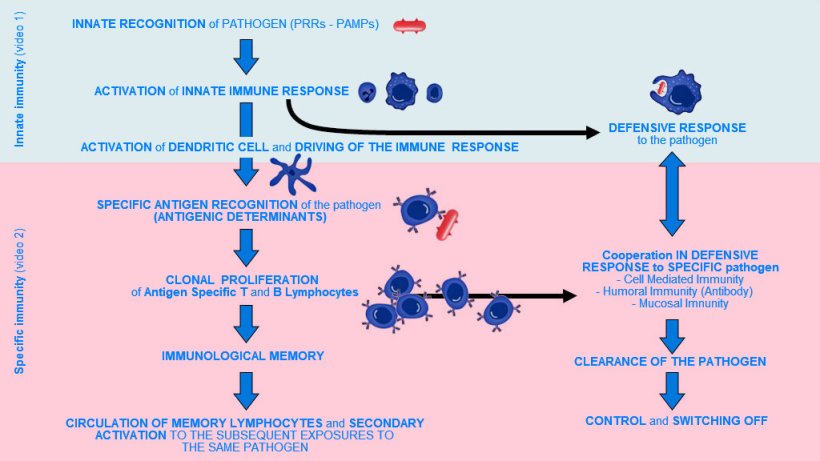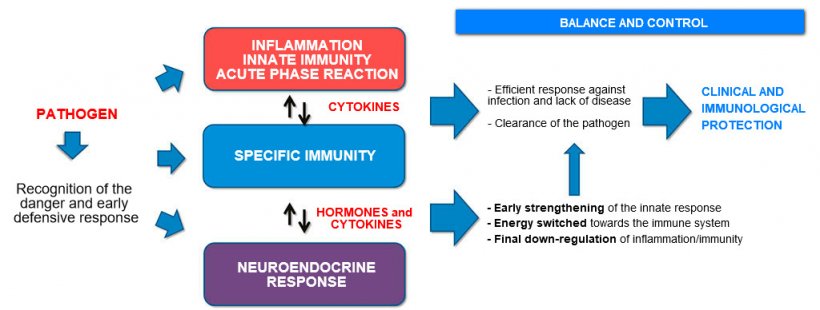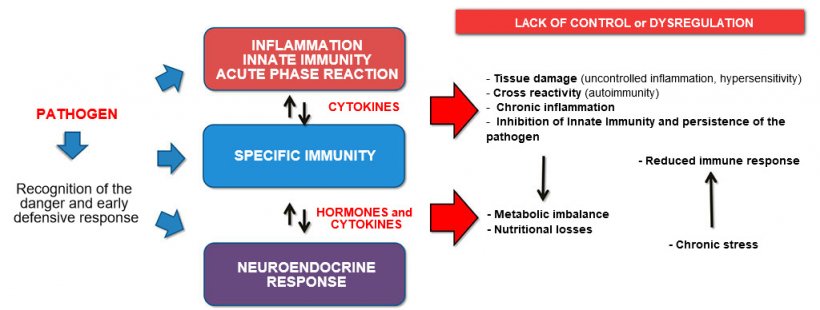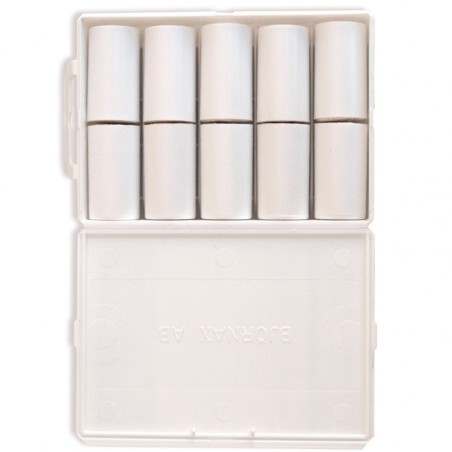Animals possess the ability (Immunity) to respond to and resist against the invasion of microorganisms thanks to a highly complex and specialized system (Immune System) of organs, tissues and cells devoted to the surveillance, detection, defensive response and elimination of foreign ("non self”), and therefore potentially pathogenic, agents.
In counteracting this attack, a defensive response (Immune response) is established, following the recognition and the link between cells and molecules of the immune system and the pathogen; this immune response aims at eliminating the pathogen from the organism ("clearance" and immunologic protection) and at sustaining the onset of “immunologic memory”, based on the survival of cells (memory cells) able to activate a specific and more efficacious immune response when the same pathogen is encountered again (Figure 1).


The Immune System is organized in lymphoid organs and tissues. These are classified as either primary or secondary lymphoid organs, based on their function, on whether they are the site of production and differentiation of lymphocytes, or whether they are involved in antigen capture and immune activation.
Immunity can be either Innate (or Natural) or Acquired (or Specific). They are different types of responses, but they are strongly connected and correlated.
Innate Immunity represents the first line of recognition and defence against pathogens and is essential both for an efficient activation of the specific immunity and for its effector response. The innate immune response is based on a prompt and short term activation of tissue cells (epithelial cells and resident tissue cells), on an early production of pro-inflammatory cytokines and the recruitment and activation of innate immune cells (macrophages, NK cells, dendritic cells, etc.).
Video 1: Innate Immunity
Acquired or Specific Immunity, divided into Humoral and Cell-Mediated Immunity (CMI), is characterized by a specific response against a well-defined antigen. It is able to recognize what is “self” (the organism’s own components) and therefore tolerated, from what is “non self” (foreign agents) and thus has to be counteracted and eliminated. This latter response needs time to select and activate the immune cells that specifically recognize a pathogen and, consequently, arises more slowly than the innate immunity. However, it is more efficacious and of longer duration. In fact, cells that have “memorized” the first contact (primary immune activation) are released and persist in the blood and they are ready to respond with stronger efficacy and promptness (secondary immune activation) to the subsequent exposure to the same antigen.
Video 2: Acquired or Specific Immunity
A classic difference between innate and specific immunity is the ability of the latter to establish a long-term memory after the encounter with and activation against a particular antigen/pathogen. Immunologists are currently studying whether the natural system of recognition can also be involved in a form of "innate immune memory".
At the same time, researchers are trying to understand why and how, in certain cases, immune activation can cause disease. Hyperactivity or the lack of control can cause allergic phenomena (hypersensitivity) and tissue injury (over-inflammation or chronic inflammation). The lack of tolerance against the organism’s own components ("self") can determine the onset of autoimmune diseases (Figure 2).
Another interesting issue is the connection and interaction between immunity and the neuroendocrine response (“neuro-immune network”). During an infection, the early activation of the neuroendocrine response can sustain innate immunity and is also involved in the late control of the immune response and inflammation. Moreover, the persistence of an infection can negatively influence neuroendocrine regulation, causing an increased catabolism and reduced growth performances. The neuroendocrine response can negatively influence the efficacy of the immune response once the organism is exposed to the effects of stressors.


An important concept, in particular for vaccinology, is the “common mucosal immune system”. This is based on the fact that exposure to an antigen occurring at a specific mucosal surface also results in an effector response in other, distant mucosal surfaces. This depends on B and T memory lymphocytes which can migrate from the lymphatic vessels to the blood and reach other surfaces. Therefore, the primary activation occurs in a specific mucosal surface (e.g., intestine) and the secondary response can take place also at a distant mucosal district (e.g. lungs, mammary gland, urogenital apparatus).






